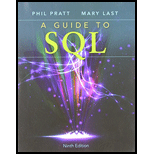
A Guide to SQL
9th Edition
ISBN: 9781111527273
Author: Philip J. Pratt
Publisher: Course Technology Ptr
expand_more
expand_more
format_list_bulleted
Question
Chapter 5, Problem 16CAT
Program Plan Intro
LEFT JOIN:
- This type of join returns all the records (rows) from the left table and the matched records (rows) from the right table.
- When the fields of right table do not match with the left one, then the fields are filled with “NULL” values.
Syntax:
SELECT column_Name(s) FROM table_Name1 RIGHT JOIN table_Name2 ON table_Name1.column_Name = table_Name2.column_Name;
In the above syntax, the left table is “table_Name1” and the right table is “table_Name2”.
ORDER BY Clause:
SQL contains “ORDER BY” clause in order to sort rows. The values get sorted in ascending as well as descending order. The keyword used to sort values in ascending order is “ASC” and for descending order is “DESC”. By default, it sorts values by ascending order.
Syntax:
SELECT column_Name1, column_Name2 FROM table_Name ORDER BY column_Name2;
Expert Solution & Answer
Trending nowThis is a popular solution!

Students have asked these similar questions
Write the SQL code that permits to implement the tables: Student and Transcript. NB: Add the constraints on the attributes – keys and other.
Draw an ERD that will involve the entity types: Professor, Student, Department and Course. Be sure to add relationship types, key attributes, attributes and multiplicity on the ERD.
Draw an ERD that represents a book in a library system. Be sure to add relationship types, key attributes, attributes and multiplicity on the ERD.
Chapter 5 Solutions
A Guide to SQL
Ch. 5 - Prob. 1RQCh. 5 - Prob. 2RQCh. 5 - Prob. 3RQCh. 5 - Prob. 4RQCh. 5 - Prob. 5RQCh. 5 - Prob. 6RQCh. 5 - Prob. 7RQCh. 5 - What does it mean for two tables to be union...Ch. 5 - Prob. 9RQCh. 5 - Prob. 10RQ
Ch. 5 - Prob. 11RQCh. 5 - Prob. 12RQCh. 5 - Prob. 13RQCh. 5 - Prob. 14RQCh. 5 - Prob. 15RQCh. 5 - Prob. 1TDCh. 5 - Prob. 2TDCh. 5 - Prob. 3TDCh. 5 - Prob. 4TDCh. 5 - Prob. 5TDCh. 5 - Prob. 6TDCh. 5 - Prob. 7TDCh. 5 - Prob. 8TDCh. 5 - Prob. 9TDCh. 5 - Prob. 10TDCh. 5 - Prob. 11TDCh. 5 - Prob. 12TDCh. 5 - Prob. 13TDCh. 5 - Prob. 14TDCh. 5 - Prob. 15TDCh. 5 - Prob. 16TDCh. 5 - Prob. 17TDCh. 5 - Prob. 18TDCh. 5 - Prob. 20TDCh. 5 - Prob. 21TDCh. 5 - Prob. 1CATCh. 5 - Prob. 2CATCh. 5 - Prob. 3CATCh. 5 - Prob. 4CATCh. 5 - Prob. 5CATCh. 5 - Prob. 6CATCh. 5 - Repeat Exercise 6, but this time use the EXISTS...Ch. 5 - Prob. 8CATCh. 5 - Prob. 9CATCh. 5 - Prob. 10CATCh. 5 - Prob. 11CATCh. 5 - Prob. 12CATCh. 5 - Prob. 13CATCh. 5 - Prob. 14CATCh. 5 - Prob. 15CATCh. 5 - Prob. 16CATCh. 5 - Prob. 17CATCh. 5 - Prob. 18CATCh. 5 - Prob. 1SCGCh. 5 - Prob. 2SCGCh. 5 - Prob. 3SCGCh. 5 - Prob. 4SCGCh. 5 - Repeat Exercise 4, but this time use the EXISTS...Ch. 5 - Prob. 6SCGCh. 5 - Prob. 7SCGCh. 5 - Prob. 8SCGCh. 5 - Prob. 9SCGCh. 5 - Prob. 10SCGCh. 5 - Prob. 11SCGCh. 5 - Prob. 12SCGCh. 5 - Prob. 13SCGCh. 5 - Prob. 14SCGCh. 5 - Prob. 15SCGCh. 5 - Prob. 16SCG
Knowledge Booster
Similar questions
- 2:21 m Ο 21% AlmaNet WE ARE HIRING Experienced Freshers Salesforce Platform Developer APPLY NOW SEND YOUR CV: Email: hr.almanet@gmail.com Contact: +91 6264643660 Visit: www.almanet.in Locations: India, USA, UK, Vietnam (Remote & Hybrid Options Available)arrow_forwardProvide a detailed explanation of the architecture on the diagramarrow_forwardhello please explain the architecture in the diagram below. thanks youarrow_forward
- Complete the JavaScript function addPixels () to calculate the sum of pixelAmount and the given element's cssProperty value, and return the new "px" value. Ex: If helloElem's width is 150px, then calling addPixels (hello Elem, "width", 50) should return 150px + 50px = "200px". SHOW EXPECTED HTML JavaScript 1 function addPixels (element, cssProperty, pixelAmount) { 2 3 /* Your solution goes here *1 4 } 5 6 const helloElem = document.querySelector("# helloMessage"); 7 const newVal = addPixels (helloElem, "width", 50); 8 helloElem.style.setProperty("width", newVal); [arrow_forwardSolve in MATLABarrow_forwardHello please look at the attached picture. I need an detailed explanation of the architecturearrow_forward
- Information Security Risk and Vulnerability Assessment 1- Which TCP/IP protocol is used to convert the IP address to the Mac address? Explain 2-What popular switch feature allows you to create communication boundaries between systems connected to the switch3- what types of vulnerability directly related to the programmer of the software?4- Who ensures the entity implements appropriate security controls to protect an asset? Please do not use AI and add refrencearrow_forwardFind the voltage V0 across the 4K resistor using the mesh method or nodal analysis. Note: I have already simulated it and the value it should give is -1.714Varrow_forwardResolver por superposicionarrow_forward
- Describe three (3) Multiplexing techniques common for fiber optic linksarrow_forwardCould you help me to know features of the following concepts: - commercial CA - memory integrity - WMI filterarrow_forwardBriefly describe the issues involved in using ATM technology in Local Area Networksarrow_forward
arrow_back_ios
SEE MORE QUESTIONS
arrow_forward_ios
Recommended textbooks for you
 A Guide to SQLComputer ScienceISBN:9781111527273Author:Philip J. PrattPublisher:Course Technology PtrNp Ms Office 365/Excel 2016 I NtermedComputer ScienceISBN:9781337508841Author:CareyPublisher:Cengage
A Guide to SQLComputer ScienceISBN:9781111527273Author:Philip J. PrattPublisher:Course Technology PtrNp Ms Office 365/Excel 2016 I NtermedComputer ScienceISBN:9781337508841Author:CareyPublisher:Cengage
- COMPREHENSIVE MICROSOFT OFFICE 365 EXCEComputer ScienceISBN:9780357392676Author:FREUND, StevenPublisher:CENGAGE L

A Guide to SQL
Computer Science
ISBN:9781111527273
Author:Philip J. Pratt
Publisher:Course Technology Ptr

Np Ms Office 365/Excel 2016 I Ntermed
Computer Science
ISBN:9781337508841
Author:Carey
Publisher:Cengage


COMPREHENSIVE MICROSOFT OFFICE 365 EXCE
Computer Science
ISBN:9780357392676
Author:FREUND, Steven
Publisher:CENGAGE L